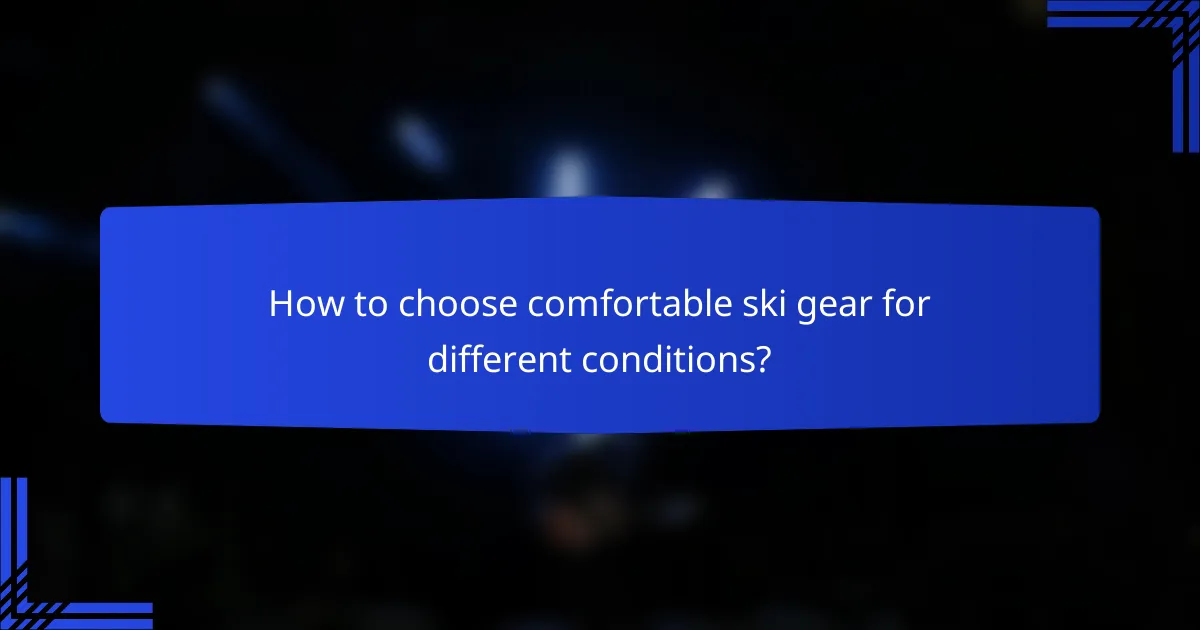Choosing the right ski gear is essential for maximizing responsiveness, comfort, and stability on the slopes. High-performance ski boots, lightweight skis, and responsive bindings work together to enhance control and agility, allowing for quicker turns. Additionally, well-designed equipment ensures comfort, enabling skiers to focus on their technique while stability features provide a secure and confident skiing experience.

What ski gear enhances responsiveness in New Zealand?
To enhance responsiveness while skiing in New Zealand, focus on high-performance ski boots, lightweight skis, and responsive bindings. These components work together to improve control and agility on the slopes, allowing for quicker turns and better handling.
High-performance ski boots
High-performance ski boots are designed to provide a snug fit and excellent energy transfer from your legs to the skis. Look for boots with a flex rating that matches your skiing style; stiffer boots offer more responsiveness, while softer boots provide comfort and ease of use.
When selecting boots, consider features like adjustable buckles and custom liners for a personalized fit. Brands like Salomon and Nordica offer models that cater to various skill levels and preferences, ensuring you find the right balance between comfort and performance.
Lightweight skis
Lightweight skis are crucial for enhancing responsiveness, as they allow for quicker edge-to-edge transitions. Opt for skis made from advanced materials such as carbon fiber or lightweight wood cores, which provide strength without added weight.
When choosing skis, consider the width and shape that best suits your skiing style. Narrower skis are typically more responsive and easier to maneuver, making them ideal for groomed runs, while wider skis offer better stability in powder conditions.
Responsive bindings
Responsive bindings play a vital role in connecting your boots to the skis, affecting how quickly you can react to changes in terrain. Look for bindings that offer a low stand height and a direct connection to the ski for optimal energy transfer.
Consider adjustable DIN settings to match your skill level and skiing style, as this can prevent pre-release during aggressive turns. Brands like Marker and Look provide a range of bindings that cater to different skiing conditions and preferences, ensuring you maintain control on the slopes.

How does comfort affect ski gear selection?
Comfort plays a crucial role in ski gear selection, as it directly impacts performance and enjoyment on the slopes. Well-designed gear enhances responsiveness and stability, allowing skiers to focus on technique rather than discomfort.
Ergonomic design
Ergonomic design in ski gear ensures that equipment fits the natural contours of the body, promoting better posture and reducing fatigue. Look for features like contoured shapes, adjustable straps, and padded areas that support key pressure points.
For example, ski boots with an ergonomic fit can significantly improve control and reduce the risk of blisters. Prioritize gear that allows for natural movement while providing adequate support to enhance overall comfort.
Insulated layers
Insulated layers are essential for maintaining warmth without sacrificing mobility. High-quality insulation materials, such as down or synthetic fibers, trap heat while allowing moisture to escape, keeping you dry and comfortable throughout the day.
When selecting insulated gear, consider the climate and your activity level. For colder conditions, look for options with higher insulation ratings, while milder climates may require lighter layers to avoid overheating.
Custom fit options
Custom fit options, such as heat-moldable liners or adjustable components, can greatly enhance comfort and performance. Many brands offer customizable features that allow skiers to tailor their gear to their specific foot shape and size.
Investing in gear with custom fit capabilities can lead to improved responsiveness and stability on the slopes. Always try on gear and consult with professionals to ensure the best possible fit for your skiing style and preferences.

What features ensure stability in ski equipment?
Stability in ski equipment is primarily ensured through design features that enhance balance and control on the slopes. Key elements include wider ski bases, stability-enhancing bindings, and advanced rocker profiles, each contributing to a more secure and confident skiing experience.
Wider ski bases
Wider ski bases increase the surface area in contact with the snow, providing better balance and reducing the likelihood of tipping. This feature is particularly beneficial for beginners or those skiing on variable terrain, as it enhances stability during turns and at higher speeds.
When selecting skis, look for models with a waist width typically ranging from 85mm to 110mm for all-mountain skiing. Wider bases can help absorb shocks from uneven surfaces, making your ride smoother and more controlled.
Stability-enhancing bindings
Bindings play a crucial role in connecting the skier to the skis, influencing stability and responsiveness. High-quality bindings are designed to provide a secure fit while allowing for some flex, which can help maintain balance during dynamic movements.
Choose bindings that are compatible with your skiing style and skill level. For instance, bindings with a lower DIN setting are suitable for lighter skiers or beginners, while those with higher settings offer more stability for aggressive skiing.
Advanced rocker profiles
Rocker profiles refer to the curvature of the ski, affecting how it interacts with the snow. Skis with a pronounced rocker in the tip and tail can enhance stability by allowing for easier turn initiation and better floatation in powder conditions.
Consider skis with a combination of rocker and camber profiles for versatility. This design allows for stability on groomed runs while still providing the ability to maneuver effectively in softer snow. Look for models that offer a moderate rocker for a balanced performance across various conditions.

What are the best brands for responsive ski gear?
The best brands for responsive ski gear focus on delivering optimal performance, comfort, and stability. Brands like Salomon, Atomic, and Nordica are renowned for their innovative designs and technology that enhance responsiveness on the slopes.
Salomon
Salomon is a leading brand known for its high-quality ski gear that emphasizes responsiveness and control. Their skis often feature advanced materials and construction techniques, providing excellent edge grip and stability in various snow conditions.
When choosing Salomon gear, consider models like the Salomon QST series, which are designed for versatility and performance. These skis cater to different skill levels, making them suitable for both beginners and advanced skiers.
Atomic
Atomic is another top brand recognized for its responsive ski equipment, particularly in the racing and all-mountain categories. Their skis are engineered with precision to ensure quick turns and stability, making them ideal for aggressive skiing.
Popular models include the Atomic Redster series, which are designed for speed and agility. Skiers looking for a competitive edge often prefer Atomic gear due to its focus on performance and responsiveness.
Nordica
Nordica specializes in ski gear that balances comfort and responsiveness, making it a favorite among recreational and expert skiers alike. Their skis are designed to provide a smooth ride while maintaining excellent control on varied terrain.
The Nordica Enforcer series is particularly well-regarded for its stability and versatility, allowing skiers to tackle everything from groomed runs to powder. When selecting Nordica gear, look for features that enhance comfort, such as adjustable bindings and cushioned boots.

How to choose comfortable ski gear for different conditions?
Choosing comfortable ski gear involves understanding the conditions you’ll face and selecting equipment that provides the right balance of warmth, breathability, and flexibility. Prioritize layering, material quality, and fit to ensure optimal performance and comfort on the slopes.
Layering strategies
Effective layering is crucial for adapting to varying weather conditions while skiing. Start with a moisture-wicking base layer to keep sweat away from your skin, followed by an insulating mid-layer for warmth, and finish with a waterproof and breathable outer layer to protect against wind and snow.
Consider the temperature and activity level when layering. For colder days, opt for thicker mid-layers, while on milder days, lighter options may suffice. Always ensure that your layers allow for movement without restricting your range of motion.
Material selection
Choosing the right materials can significantly impact your comfort on the slopes. Look for fabrics that offer breathability, moisture-wicking properties, and insulation. Common materials include merino wool for base layers, fleece for mid-layers, and Gore-Tex or similar fabrics for outer layers.
Pay attention to the weight of the materials as well. Lighter fabrics are great for mobility, while heavier options provide more warmth. Ensure that the materials are durable enough to withstand the rigors of skiing, especially if you ski frequently.
Fit considerations
Fit is essential for comfort and performance in ski gear. Ensure that your clothing allows for layering without being too tight or too loose. A snug fit helps retain warmth, while a looser fit can hinder movement and lead to discomfort.
When trying on gear, move around as you would while skiing—bend, twist, and squat. This will help you assess whether the fit is right. Remember that ski boots should fit snugly but not painfully, as proper fit enhances control and responsiveness on the slopes.

What are the key criteria for selecting stable ski equipment?
When selecting stable ski equipment, the primary criteria include weight distribution, flex rating, and construction materials. Each of these factors significantly impacts your control, comfort, and overall performance on the slopes.
Weight distribution
Weight distribution refers to how the skier’s weight is balanced across the skis. Proper weight distribution enhances stability and control, allowing for smoother turns and better handling in various snow conditions. Skis with a balanced weight distribution help maintain equilibrium, reducing the risk of falls.
To achieve optimal weight distribution, consider your stance and the ski’s design. For instance, a center-mounted ski is ideal for freestyle skiing, while a rear-mounted ski offers more stability for downhill racing. Always ensure your bindings are adjusted correctly to match your weight and skiing style.
Flex rating
The flex rating of a ski indicates how stiff or soft it is, which affects responsiveness and stability. Softer skis are generally easier to maneuver and are suitable for beginners or those who prefer a more relaxed style. In contrast, stiffer skis provide better stability at high speeds and are favored by advanced skiers.
Flex ratings typically range from soft (around 60-70) to stiff (over 100). When choosing a flex rating, consider your skill level, skiing style, and the terrain you plan to tackle. A common pitfall is selecting a ski that is too stiff for your ability, which can hinder performance and enjoyment.
Construction materials
The construction materials of skis play a crucial role in their performance and durability. Common materials include wood cores, fiberglass, and carbon fiber, each offering different benefits. Wood cores provide a natural feel and good vibration dampening, while carbon fiber adds strength and reduces weight.
When evaluating construction materials, consider the trade-offs between weight, durability, and performance. For instance, lighter skis made with advanced materials may enhance agility but could sacrifice some stability. Always look for skis that balance these factors according to your skiing preferences and the conditions you typically encounter.
